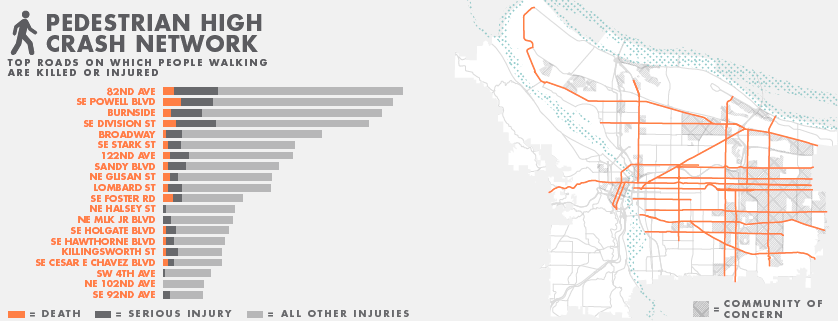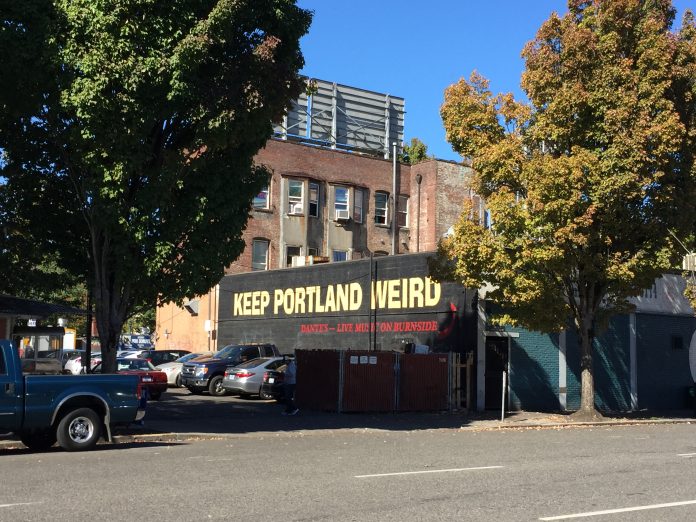Last week the city council of Portland, Oregon signed on to the Vision Zero action plan that has been developed by the Portland Bureau of Transportation (PBOT) as part of its proposal to eliminate serious deaths and injuries on city streets by 2025, a full five years sooner than Seattle’s current goal of Vision Zero by 2030.
Previously the Portland council, which is made up of five members including the mayor, had announced that it endorsed the idea of ending traffic fatalities on Portland streets, but this plan lays out a full list of 32 actions which the city intends to carry out to achieve the goal, 21 of them in just the next two years. Their action, however, does not allocate any additional funding toward the goal: the council did clarify, however, that a new tax on marijuana in Portland would allocate some money toward safer streets, around $3 million per year.
The action plan identifies five areas on which the city can focus to reduce serious injury or death: street design, impairment, speed, dangerous behaviors, and education and accountability. Within these categories are items that cities across the country, including Seattle, are using to make streets safer.
Notably, Portland City Commissioner (aka councilmember) Nick Fish questioned the director of PBOT, Leah Treat, which one of the action items listed in the plan that she would select as having the most impact. “I would recommend to council that our investments focus on road diets and re-engineering roadways. That will have the most impact on slowing people down.”
Tying safety directly to lowering speeds is something that indicates that PBOT is moving in the right direction on Vision Zero. Currently, however, Portland is not able to follow Seattle’s lead on making its own decisions with regard to speed limits on neighborhood streets. One of the Vision Zero action plan’s items is to obtain that authority.

Portland’s mayor, Charlie Hales, was not on hand to vote on the legislation, as he was attending a conference in Mexico City on the issue of climate change. Seattle Mayor Ed Murray, also on hand at the conference, tied the goals of the climate change summit to Seattle’s transportation vision in a tweet: “For West Coast cities, reducing our carbon footprint means taking a multi-modal approach to transportation.”

The City of Portland has been dealing with several high-profile fatalities as of late that have galvanized support for the movement in a way that only tragedies can. In October, a cyclist was killed crossing the St. John’s Bridge, a four-lane bridge used by freight that only has painted sharrows for bikes. And this past August, a 15-year-old girl was killed crossing the street on Hawthorne when a driver stopped for her and another driver tried to overtake in the center turn lane. What was originally a temporary memorial in that center turn lane turned into an act of tactical urbanism as activists used the memorial to prevent traffic from using the lane. The memorial was eventually removed by PBOT later in the summer. Portland’s fatal collision rate is slightly higher than Seattle’s, with 6.2 people per 100,000 residents killed by traffic per year on average in Portland and 5.2 in Seattle. So our sister city to the south has an uphill road in front of them, but our two cities should do the best we can to work together to make our streets safe for everyone.
The Portland Bureau of Transportation has an interactive Vision Zero website which explains all of the facets of its action plan.
Ryan Packer has been writing for The Urbanist since 2015, and currently reports full-time as Contributing Editor. Their beats are transportation, land use, public space, traffic safety, and obscure community meetings. Packer has also reported for other regional outlets including Capitol Hill Seattle, BikePortland, Seattle Met, and PubliCola. They live in the Capitol Hill neighborhood of Seattle.



